I’m certain that most cyclists would agree that one of humanity’s greatest inventions is the wheel. Since its first creation, the wheel has come a long way to now take its prominent role in U.S. streets across the country. How did we get to the two-wheeled contraption that now serves as a main source of transportation, recreation, and competition in American society today? Below is a run through the history of the bicycle, as provided by pedalinghistory.com and ibike.org:
1418 – The first human-powered land vehicle was created by Giovanni Fontana which travelled on four wheels and was propelled by pulling a rope that connected to gears located on the tires.
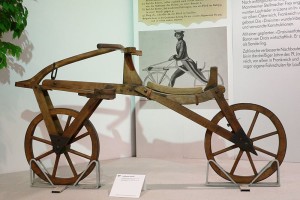
1817 – Baron von Drais invented the “Walking Machine” for travelling through the royal gardens faster. This device consisted of two in-line wheels mounted in a horizontal frame which the rider straddled—both the frame and the wheels were made out of wood. Steering occurred through a single handle that was attached to the front wheel, and the vehicle was powered by the rider’s legs propelling him or her off of the ground. Although the wooden walking machine—also known as the hobby horse or the Draisienne—was fashionable for a time, the machine could not handle rides over streets that were not maintained and was thus impractical.
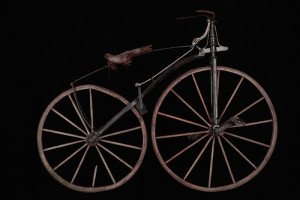 1865 – The next two-wheeled travelling machine was known as the velocipede, or “fast foot”. Like the walking machine, this bicycle ancestor was made out of wood— though it did eventually switch to using metal tires— and was steered by the front wheels. Unlike the walking machine, the velocipede featured pedals attached to the front tires. This machine was commonly known as the boneshaker due to the discomfort experienced while riding the wooden contraption over bumpy, cobblestone streets. Because of the discomfort that the “boneshaker” produced, this machine eventually became a less popular means of transportation.
1865 – The next two-wheeled travelling machine was known as the velocipede, or “fast foot”. Like the walking machine, this bicycle ancestor was made out of wood— though it did eventually switch to using metal tires— and was steered by the front wheels. Unlike the walking machine, the velocipede featured pedals attached to the front tires. This machine was commonly known as the boneshaker due to the discomfort experienced while riding the wooden contraption over bumpy, cobblestone streets. Because of the discomfort that the “boneshaker” produced, this machine eventually became a less popular means of transportation.
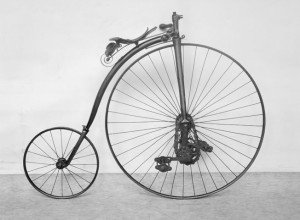 1870 – This era produced the first, fully metal design and the forging of the name “bicycle.” This machine, known as the high wheel bicycle, stands as a symbol of the industrial period. It represents the point at which metallurgy could produce a metal that was strong enough and light enough to be made into an efficient travel device. Though the large front wheel allowed for the rider to travel at a fast speed, it proved difficult to mount and dangerously prone to the smallest obstructions. The high wheel bicycle tire was made of solid rubber with long spokes which lessened the bone-shaking effect of previous designs.
1870 – This era produced the first, fully metal design and the forging of the name “bicycle.” This machine, known as the high wheel bicycle, stands as a symbol of the industrial period. It represents the point at which metallurgy could produce a metal that was strong enough and light enough to be made into an efficient travel device. Though the large front wheel allowed for the rider to travel at a fast speed, it proved difficult to mount and dangerously prone to the smallest obstructions. The high wheel bicycle tire was made of solid rubber with long spokes which lessened the bone-shaking effect of previous designs.
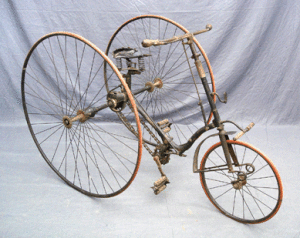 1880’s – The high wheel tricycle afforded a bit more safety and dignity, at least for women, doctors, and clergymen who did not wear the most comfortable clothing for a high-seated bicycle. Many mechanical innovations associated with automobiles—including rack and pinion steering, the differential, and hand brakes—were invented during the 1880’s for tricycles.
1880’s – The high wheel tricycle afforded a bit more safety and dignity, at least for women, doctors, and clergymen who did not wear the most comfortable clothing for a high-seated bicycle. Many mechanical innovations associated with automobiles—including rack and pinion steering, the differential, and hand brakes—were invented during the 1880’s for tricycles.
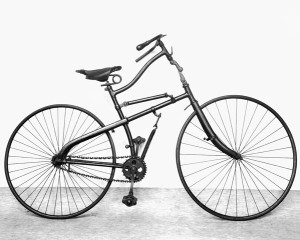 1890’s – The Safety Bicycle lost the big wheels and returned to the lower-seated designs of nearly 100 years ago. While previous designs had pedals attached directly to the front wheels, the Safety Bicycle was the first to connect the pedals to the back wheels through a chain and gear system. Although this design was considerably safer than the high-wheel designs, it returned to the issue of comfort which the end of the decade would eliminate through the invention of the pneumatic tire. This bicycle marked the era in which bicycles became practical and affordable for the common worker and thus a popular means of travel.
1890’s – The Safety Bicycle lost the big wheels and returned to the lower-seated designs of nearly 100 years ago. While previous designs had pedals attached directly to the front wheels, the Safety Bicycle was the first to connect the pedals to the back wheels through a chain and gear system. Although this design was considerably safer than the high-wheel designs, it returned to the issue of comfort which the end of the decade would eliminate through the invention of the pneumatic tire. This bicycle marked the era in which bicycles became practical and affordable for the common worker and thus a popular means of travel.
1920’s – All of the designs used to make the safety bicycle, the tricycle, and the pneumatic tire were now being miniaturized in kids’ designs, showing how deeply the bicycle had integrated itself into American society.
 Now – The invention and improvement of the bicycle continues even today! Just in the past few years, new designs to tires, frames, pedal mechanics, and more are emerging to provide a safer and more comfortable ride.
Now – The invention and improvement of the bicycle continues even today! Just in the past few years, new designs to tires, frames, pedal mechanics, and more are emerging to provide a safer and more comfortable ride.
At Christensen and Hymas, we are concerned with your safety and well-being. Remember to drive safe, take all precautions to avoid injury, and enjoy yourself on your two-wheel machine.
